Learning with Lynda
When you're trying to learn the basics of a new piece of software you've purchased, or when you want to pick up some of the application's finer points, you might want to know Lynda. Lynda Weinman, that is. She's the co-founder of Lynda.com, the on-line library of training videos. Although the training videos range in subject matter from Perl programming and how to get the most out of Ebay to Joomla and Drupal, by far the most common subjects are Adobe Photoshop, other components of the Creative Suite, and digital photography. As I tell you more, you'll understand why.
I frequently use Lynda.com for background information when I'm working with a new application or a new version of an application that I've worked with previously. It's a quick and easy way to learn how something works by watching expertsiuse it.
 Lynda.com has an online training library that consists of more than 650 courses and related exercise files. The programs have been created by subject matter experts. Among the topics covered are Microsoft Office, open source software, Macintosh applications, multimedia, Web design, and programming.
Lynda.com has an online training library that consists of more than 650 courses and related exercise files. The programs have been created by subject matter experts. Among the topics covered are Microsoft Office, open source software, Macintosh applications, multimedia, Web design, and programming.
One thing that I found a bit surprising, though, is the fact that some colleges and universities use the company's programs as part of classroom curricula. But it makes sense. Although I still like reference books because I can quickly find what I'm looking for in a well indexed book, the training videos are appealing because they usually come with sample files that a student can use to follow what the instructor is doing. And because the videos are online, the student can review them at any time.
 One of the colleges that's experimenting with the use of Lynda.com training videos is Indiana University. IU staff, faculty, and students can view any training program on the site until June 30, 2010.
One of the colleges that's experimenting with the use of Lynda.com training videos is Indiana University. IU staff, faculty, and students can view any training program on the site until June 30, 2010.
"IU is developing innovative programs that consider user preferences and learning styles to advance the IT skills of faculty, staff, and students," said Stacy Morrone, Associate Dean for Learning Technologies. "The lynda.com video-based e-learning options are wide-ranging and especially well suited to varying skill levels, self-directed explorations, and delivery on demand."
IU stresses that the online programs are to be used in conjunction with classroom work. Students can view the programs at any time and work their way through Adobe CS4 courses and exercise files. Faculty can incorporate fee-free video training into their curriculum or assign outside training. This eliminates the need to spend limited class time on a given tool.
Why the Heavy Graphics Component
I can think of two reasons why so many of the applications that Lynda.com teaches involve graphics and photography. First, these visual applications lend themselves to the kind of on-line training that the company does best. But it's probably also because co-founder Lynda Weinman is a graphics professional who has written books on Web design, taught at Art Center College of Design in Pasadena, worked as an animator and motion graphics director, and has been a consultant to Adobe, Macromedia, and Microsoft.
Bruce Heavin, who is Lynda's husband, is the other co-founder of the business. He is a graduate of Art Center College of Design in Illustration and he is a painter and illustrator who works with traditional and electronic media. So that might explain the emphasis on graphics.
 Bottom Line: When you want to learn, this is a good place to start.
Bottom Line: When you want to learn, this is a good place to start.
Lynda.com can help you learn how to use your digital camera, how to get the most out of Adobe applications, and even how to succeed with Ebay. Later versions offer captions and for a small extra fee, you'll have access to all of the sample files that help you follow what the instructor is doing. Subscriptions start at $25 per month.
For more information, visit the Lynda.com website.
The Changing Spam and Scam Landscape
Like the city dump in a windstorm, spammers and scammers keep changing the landscape. The underlying goal is always the same, but the techniques keep changing. I gave the slop bucket a closer look than normal this week and fished out a few smelly pieces to share.
 I have to give the scammer credit for developing a really good hook. Maybe you've seen some of the "Is this your picture?" scams, but this one shifts into high gear and is guaranteed to snag someone who has a quick temper and who isn't too bright. The message claims to be from Maura Sanford and the subject line is "some jerk has posted your photos". Following some inflammatory text, the message includes a link to the photos. Following the link is almost certain to result in an infected computer.
I have to give the scammer credit for developing a really good hook. Maybe you've seen some of the "Is this your picture?" scams, but this one shifts into high gear and is guaranteed to snag someone who has a quick temper and who isn't too bright. The message claims to be from Maura Sanford and the subject line is "some jerk has posted your photos". Following some inflammatory text, the message includes a link to the photos. Following the link is almost certain to result in an infected computer.
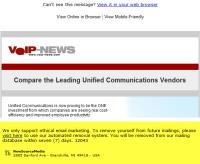 These next 3 are a set. Notice the yellow area at the bottom of each. It wasn't yellow on the original message; I've just shaded it to call your attention to it.
These next 3 are a set. Notice the yellow area at the bottom of each. It wasn't yellow on the original message; I've just shaded it to call your attention to it.
The first message is about VOIP (voice over IP) and promises a study that will help you choose a vendor.
At the bottom, there's a claim about ethical marketing and the name of a company in Michigan.
 The second is purportedly for DISH Network.
The second is purportedly for DISH Network.
The message at the bottom makes the same claim about ethical marketing, but this time the company claims to be in San Diego.
 Behind door number 3, we have a spam from a "Christian" media company.
Behind door number 3, we have a spam from a "Christian" media company.
Of course, the spammer claims to support only ethical marketing (word for word). But this time they forgot to lie about what city they're located in.
 This next message is amusing because it includes only the disclaimer. The pitch itself is missing. Apparently it was supposed to be a graphic, but all that's left is "Click Here!"
This next message is amusing because it includes only the disclaimer. The pitch itself is missing. Apparently it was supposed to be a graphic, but all that's left is "Click Here!"
This one claims to be from Microsoft and says I'm receiving it because I subscribed to MSN Featured Offers, which (as you probably already know) I did not. Had I done so, it wouldn't have been from this address.
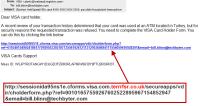 Oh, no! My Visa card beginning in "4" has been used in Turkey.
Oh, no! My Visa card beginning in "4" has been used in Turkey.
The number is meaningless. All Visa cards begin with 4. The first 4 digits identify the bank.
The fraudster wants me to follow the link, which claims to go to Visa, but really goes to a website in the United Kingdom.
 Here's one that tells me that it can help me work smarter instead of harder and make more money. They want me to take a test.
Here's one that tells me that it can help me work smarter instead of harder and make more money. They want me to take a test.
And, when I scrolled to the bottom of the long message, I found my old friend ...
![]() ... "We only support ethical email marketing. To remove yourself from future mailings, please .... And so on. This time, the spammer said he was in Clearwater, Florida.
... "We only support ethical email marketing. To remove yourself from future mailings, please .... And so on. This time, the spammer said he was in Clearwater, Florida.
It could be that each of several creeps bought the same spamming tool and that some of them know more about how to run it than others. Or it could be one large spamming operation. It doesn't matter much either way. No matter how you slice it, it's baloney.
 The "we were unable to deliver your package" messages continue to be popular. These always come with a zip file that carries the payload designed to turn your computer into a zombie.
The "we were unable to deliver your package" messages continue to be popular. These always come with a zip file that carries the payload designed to turn your computer into a zombie.
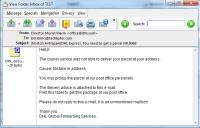 Here's another similar message, but it claims to be from DHL.
Here's another similar message, but it claims to be from DHL.
The people who send these seem not to comprehend the difference between parcel delivery services and post offices.
In other words, they're not too bright.
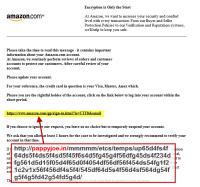 A Listserv-based discussion list I'm associated with has been receiving fraudulent messages for the past several weeks. Sometimes 20 or 30 in a single day. They're all rejected by the server, but they show up in my mailbox.
A Listserv-based discussion list I'm associated with has been receiving fraudulent messages for the past several weeks. Sometimes 20 or 30 in a single day. They're all rejected by the server, but they show up in my mailbox.
This one claims to be from Amazon and wants me to update my account.
The problem is that the server the link goes to is really located at a domain called "pappyjoe" in India.
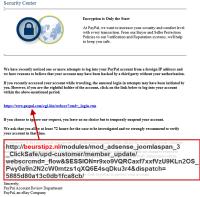 A later variant claimed to be from PayPal. Do you see my name on this message anywhere?
A later variant claimed to be from PayPal. Do you see my name on this message anywhere?
PayPal always uses a subscriber's name. Don't depend on that to ensure that a message is real because fraudsters will eventually figure out how to mimic this. But if your name isn't there, it's certain to be fraudulent.
This one would take me to a server in Netherlands.
 More than a dozen of these messages arrived between 4:30 pm on January 26 and the following evening.
More than a dozen of these messages arrived between 4:30 pm on January 26 and the following evening.
Despite the fact that a bit of cooperation among providers would eliminate the flow of crud, or at least stem the tide, that cooperation has not been forthcoming.
For now, all you can do is pay careful attention and avoid clicking questionable links.
PC Magazine Utilities: $20 Well Spent
In the early days, PC Magazine published a utility every month. The article explained how the utility worked and showed the source code. Over the years, this changed and now PC Magazine has a $20-per-year utilities option. Subscribe and you can download any of the magazine's utilities for an entire year. For my money, it's a good way to spend $20.
The magazine no longer publishes a new utility every month and sometimes an older version of a new utility works better, but there's at least $20 worth of good stuff here. The following is an extremely abbreviated list that includes some of the best and some of the most useless utilities. My comments are in bold.
| Name | Platforms | Date | Version | Description |
| AltTabIt! | XP | 2003 | 1/19/2006 | 1 | AltTabIt
enhances task switching by showing screen shots of all running
windows, sorting window lists by name, title, or z-order, and launching
pre-selected apps and files. Although this is useful, it's not needed if you have Vista or Windows 7. |
| ANSI.com | 95 | 98 | 2/7/1989 | 1.3 | ANSI.com
is a memory-resident utility that enables selectable use of the extended
screen and keyboard control sequences. Useless these days. Twenty years ago, it was useful. |
| AutoWhat? 2 | 95 | 98 | NT | 2000 | ME | XP | 3/26/2002 | 2.1 | AutoWhat?
2 lets you edit the data used in IE's AutoComplete feature. Ever find something you don't want in the auto-complete buffer? Maybe it's a misspelled name or a wrong URL. This utility lets you change or delete the problem entry. |
| BHO Cop | 95 | 98 | NT | 2000 | ME | 5/22/2001 | 1 | Lets
you disable Browser Helper Objects without uninstalling them. A decade ago, this was new and useful. Now there are better options. |
| ContextEdit | 95 | 98 | NT | 2000 | ME | XP | 2/6/2001 | 1.2 | Control
which items appear on Windows Explorer context menus. Note that neither this item nor the one below (a later version) is shown as being compatible with Vista or Windows 7. |
| ContextMenu Plus | 98 | 2000 | ME | XP | 10/14/2003 | Simplify, streamline and "pump up" your context menus with ContextMenu Plus. | |
| CursorDance | 95 | 98 | NT | 11/16/1999 | 1.1 | Design
unique animated Windows mouse pointers with CursorDance. This is another of those utilities that seemed so very clever a decade ago. Most people grew tired of things like this about 5 minutes after installing them. |
| DecoMenu | 95 | 98 | NT | 7/1/1998 | 1 | Now
you can use a customized bitmap to decorate the Windows 95 or 98 Start menu. Great if you're still running Windows 95, Windows 98, or Windows NT. Are you? |
| DiskJunction | XP | Vista | Windows7 (32 | 64) | 5/21/2009 | 1.0.0.2 | Find,
Create, and Delete Symbolic Links. Here's an interesting utility for advanced users. If you don't know what a symbolic link is, you probably shouldn't download it. |
| EndItAll 2 | 95 | 98 | NT | 2000 | ME | XP | 10/16/2001 | 2 | When
you've got to close down all the tasks running on your system, our newest
utility, EndItAll 2, tells you what's running and which are safe to close. This is the utility that can kill a program that refuses to shut down. Of course, the built-in Task Manager can do the same thing, and Windows 7 can whack just about any application that refuses to close. |
| File Utility Pack 2 | 2000 | XP | Vista (32 | 64) | 8/28/2008 | 2 | Manipulate,
batch rename, and gather information about your files, all with one great
bundle. Several file utilities, including a highly flexible file renamer. |
| FileSnoop 2 | 98 | 2000 | ME | XP | 7/27/2005 | 2.0.5 | FileSnoop
2 lets you quickly obtain all essential information about the files on your
system. Nothing too surprising here, but a useful utility. |
| HomePatrol | 2000 | XP | Vista (32 | 64) | 12/22/2008 | 1.0.0.4 | Capture
Crooks in the Act. Leave your computer on and use the Web camera to keep an eye on your room while you're not there. Is this cool or not? (Not.) |
| MultiRen | 95 | NT | 6/9/1998 | 1 | MultiRen
lets you rename groups of files from within Windows Explorer. In some ways, this utility is better than the renamer that's included in the File Utility Pack 2 shown above. |
| Rouser | 95 | 98 | NT | 5/1/1998 | 1 | Alarm
clock. How 1998: Here's a way to turn your $2000 computer into a $3 alarm clock. |
| Startup Cop Pro 4 | XP | Vista | Windows7 (32 | 64) | 4/30/2009 | 4 | Control
Windows Startup Now in version 4, clearly this has been a useful application. Windows has built-in methods for controlling what starts with the system, but this makes selecting startup applications easy. It's one of the most useful utilities in the set. |
| Vista Logon Changer | Vista | Windows7 (32 | 64) | 3/30/2009 | 1.0.0.29 | Personalize
Your Windows Bootup. This allows you to change the screen that the boot process displays and it's supposed to work works with both Vista and Windows 7, either 32- or 64-bit. It does not work on my Windows 7 machines. |
| What's Going On? | 2000 | XP | Vista | 3/9/2009 | 1.0.1.3 | Get
easy access to stats like hard drive activity, external IP address, CPU
consuming processes, uptime, and more. It's a fairly intrusive monitor application, but you can collapse it to the Tray. |
You'll find all the downloads here. If you've installed Windows 7, you'll find a lot of utilities that no longer work or are no longer needed. But even for Windows 7 users, there may be enough here to be worth $20. It all depends on how you use your computer and what utilities you already have.
If you've listened to my blather for more than a couple of episodes, you know that I'm a self-admitted utility junkie.
 Bottom Line: Utilities do one thing and do it well
Bottom Line: Utilities do one thing and do it well
In general, that's also a good description for the PC Magazine Utilities Library. You won't find any big applications here, but you will find decent workmanship and small applications that do one thing well.
For more information, visit the PC Magazine website.
Short Circuits
Touching Amazon's Kindle
The fact that no small number of Mac fans have dissed the Ipad (for its lame name, weak feature set, and operating system) hasn't kept some in the Windows community from gushing over how wonderful it is. Even those who might be inclined to buy one, perhaps remembering the painful lessons of early Iphone buyers, are waiting for version 2. But the Ipad got Amazon's attention and the company reacted quickly.
Amazon has acquired a company called Touchco, a maker of touch-screen technology. What's particularly interesting about this company's products is that more than one person can touch the screen at the same time.
Nobody is talking about the terms of the deal, but it's known that Touchco is a tiny start-up with fewer than 10 employees. The New York Times says it began as a project at New York University's Media Research Lab.
The new technology would add about $10 to the production cost of Amazon's Kindle reading devices, which compares favorably with the cost of Apple's touch screen technology. Very favorably.
Besides costing less, the Touchco technology is said to be more versatile because it can record multiple contact points simultaneously.
If it's nothing else, the Ipad would be a decent reader device, but the Kindle has a big head start in that market and clearly Amazon isn't willing to cede any territory.
Amazon earlier announced plans for an online application store like the one Apple has for Ipod and Iphone applications. This will be an interesting battle to watch.
A Monster for Yahoo
Yahoo continues to shrink. The goal is to put emphasis on its core business units and spin off those operations that aren't key to Yahoo's core competencies. The latest to go is HotJobs, acquired by Monster for $225 million. Monster says the job market is improving and the acquisition makes sense in today's marketplace.
Monster already has about one third of all US job listings and the deal would leave Monster with just one significant competitor, CareerBuilder.com. The company says it doesn't expect regulators to be concerned with the deal because of the size (small) of HotJobs, which had 2009 revenue of about $100 million compared to Monster's nearly $1 billion.
The deal calls for Monster to pay Yahoo between $20 and $31 million per year for traffic redirected from Yahoo to Monster. The deal should close by September at the latest.
Monster says it will double the number of newspapers it works with. That number is now about 500.


 The author's image: It's that photo over at the right. This explains why TechByter Worldwide was never on television, doesn't it?
The author's image: It's that photo over at the right. This explains why TechByter Worldwide was never on television, doesn't it?
